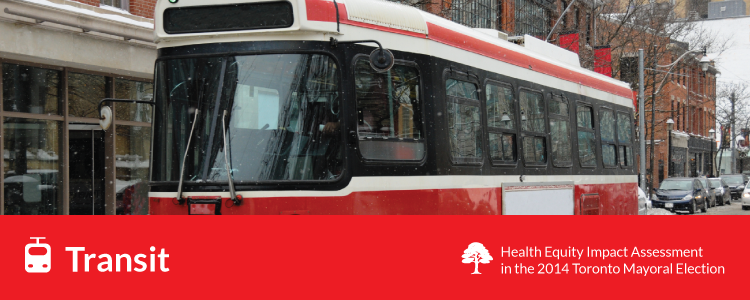Transit is critical to how cities move, grow and interact. Having access to high quality public transit opens doors for people to travel to and from work, school, grocery stores, recreation spaces, and places to socialize. However, our current transit system has significant accessibility and affordability barriers for many Torontonians.
Transit service coverage is an important determinant of ridership,1 but the availability of public transit varies significantly across Toronto. The Martin Prosperity Institute developed a transit score index that estimated the availability of transit in neighbourhoods across the city based on density of stops and frequency of service and vehicle capacity. The index showed high transit scores in the downtown core but much lower scores in the inner suburbs.2
Fare affordability is also a major determinant of whether people use public transit.3 A monthly MetroPass costs $133.75 for adults and $108 for seniors and students4 , which makes Toronto’s TTC system one of the least affordable among Canadian cities. A review by Toronto Public Health found that in 2009 a MetroPass would cost a minimum wage earner in Toronto 7.1 percent of their monthly income or 20 percent of the income of a single person receiving Ontario Works.5 TTC fare increases in recent years have only been applied to monthly passes and tokens and not to cash fares.6
A health-enhancing transit plan would commit to making transit affordable for all Torontonians, improve transit access in under-served parts of Toronto, and connect communities to important locations like grocery stores, workplaces and schools.
Health Impacts of Transit
Access to affordable and convenient transportation can have positive health benefits. Residents in the GTA have the longest commute times in Ontario, with people living in Toronto commuting an average of 65.6 minutes per day.7 Longer commute times have been shown to contribute to behaviours that may result in poor health over time. People who commute tend to spend less time on physical activity, food preparation, eating with their family, and sleeping.8 Long commutes may erode time spent with family and friends, which can affect social satisfaction and may contribute to poor physical and mental health.9
There are links between use of public transit and increased physical activity. Adults who use public transit are more physically active than those who use other methods of transportation and may have lower BMI scores. Transit-related walking, like walking to a bus stop, has been shown to contribute to an overall gain in daily physical activity.10
Neighbourhood physical environments can also influence travel choice, with more easily walkable neighbourhoods being more transit friendly. Transit stations that are surrounded by highly-walkable neighbourhoods contribute to more passengers walking to transit. Transit users who live in less-walkable neighbourhoods are more likely to drive to suburban stations.11 A study in Utah tracked activity levels of people living in a low income neighbourhood before and after a new light rail station was constructed. The study found that the new station contributed to an increase in moderate physical activity and that neighbourhood residents may have begun to walk more even when not using transit as they discovered important community assets like parks and shops.12
Health Equity Impacts of Transit
Not everybody in Toronto has equitable access to high-quality public transit, and this can have inequitable impacts on the lives and health of those who lack adequate transit options. In Toronto, people with low income face affordability barriers in accessing transit. Toronto’s transit system provides better coverage in the downtown core than in the inner suburbs13 which have higher rates of poverty.14 Despite this, research by Toronto Public Health found that the lowest income commuters – those earning less than $20,000 per year – are 1.6 times more likely than the highest income commuters to use public transit to get to work.15 This means that people with low income who live in Toronto’s inner suburbs may have no option but to pay unaffordable transit fares, which can impact the ability to afford other essential items like nutritious food.
While walking to transit may have positive health benefits, access to high-quality, easily accessible transit is often stratified by income, with people with lower income and education often having to walk further to transit connections.16 Lower income neighbourhoods often lack physical infrastructure that supports safe and convenient walking, so walking to transit may be a poverty-related necessity rather than a health-enhancing choice.
People who work in irregular employment may face barriers getting to and from work owing to poor transit coverage outside of peak periods. For people who work during regular business hours, transit availability and accessibility may be satisfactory, but for people who work in service jobs that have irregular hours and are located over wide geographic areas having few transit options when and where they are needed may be a barrier to employment.17
Older people and people with disabilities may face additional barriers to accessing transit. Only 32 of Toronto’s 69 subway and RT stations are accessible18 and the planned completion of accessibility improvements has been delayed from 2020 to 2025 owing to a capital budget shortfall.19 The roll-out of the city’s new accessible streetcars will not be completed until 2018/19.20 Moreover, people with disabilities experience higher rates of poverty and lower rates of employment than other Torontonians, which may compound challenges in accessing transit.21
How do Toronto’s Leading Mayoral Candidates Measure Up for Equity in Transit?
 Chow |
 Ford |
 Tory |
|
|---|---|---|---|
| Affordability |
|
|
|
| Accessibility |
|
|
|
| Network Expansion |
|
|
|
Transit for a Healthier Toronto
Having access to affordable transit is important to being able to being able to access education, employment, social contacts, and other essentials like nutritious food and child care. While all three of the main mayoral candidates have transit plans, none have addressed the health and health equity impacts of transit.
None of the main mayoral candidates have addressed transit fare affordability. This is a significant omission given that Toronto’s transit system is one of the most expensive in Canada. Moreover, City Council voted in July 2014 to have the TTC and city departments examine a proposal to develop a fare equity strategy.22 A fare equity strategy that includes discounted travel for people with low income could help to improve the health of marginalized Torontonians.
Despite the numerous accessibility barriers across Toronto’s transit system, none of the main mayoral candidates have addressed transit accessibility. While Toronto has a plan to make all of its subway and RT stations accessible, a lack of adequate capital funding has resulted in a five-year delay in completing these projects. This delay means continued obstacles to participating in our city for seniors, people with disabilities, and others requiring barrier-free transit access.
The major transit debates among Toronto’s mayoral candidates have centred on plans to expand the existing network to improve ridership and reduce traffic congestion. While this is important, none of the mayoral candidates have addressed the need for transit to connect people with essential resources, such as education, grocery stores and child care services. Only Tory has directly addressed the need for transit to connect people to employment – his regional express rail proposal would create new rapid transit connections to employment centres in the city’s north-east and north-west, in addition to improving access from the suburbs to the downtown core.
Chow’s commitment to increase Toronto’s rush hour bus capacity by 10 percent is important. Buses are a key component of Toronto’s transit system and service level cuts in 2010 have resulted in overcrowding. However, reliable bus services are also important outside of peak periods, including for people who work irregular hours in service industries. It is important to protect Toronto’s Blue Night Network buses and to look for ways to improve services for people who commute off-peak.
Download our Transit Health Equity Impact Assessment
- C. Chen, D. Varley & J. Chen, ‘What Affects Transit Ridership? A Dynamic Analysis involving Multiple Factors, Lags and Asymmetric Behaviour, Urban Studies 48(9), 2011. ↩
- Martin Prosperity Institute, The Many Cities of Toronto’s Public Transit. Accessed August 28, 2014. http://martinprosperity.org/2012/08/09/the-many-cities-of-torontos-public-transit/. ↩
- Chen, Varley & Chen, 2011. ↩
- Toronto Transit Commission, Prices, Accessed August 28, 2014. https://www.ttc.ca/Fares_and_passes/Prices/index.jsp. ↩
- Toronto Public Health, Next Stop Health: Transit Access and Health Inequities in Toronto, 2013. ↩
- Toronto Transit Commission, 2014 TTC and Wheel-Trans Operating Budgets, Accessed August 28, 2014. http://ttc.ca/About_the_TTC/Commission_reports_and_information/Commission_meetings/2013/November_18/Reports/2014_TTC_AND_WHEEL_T.pdf. ↩
- Canadian Index of Wellbeing, How are Ontarians Really Doing? A Provincial Report on Ontario Wellbeing, Waterloo: Canadian Index of Wellbeing & University of Waterloo, 2014. ↩
- T.J. Christian, ‘Trade-Offs Between Commuting Time and Health-Related Activities’, Journal of Urban Health 89(5), 2012. ↩
- E.C. Delmelle, E. Haslauer & T. Prinz, ‘Social Satisfaction, Commuting and Neighborhoods, Journal of Transport Geography 30, 2013. ↩
- B.E. Saelens, A.V. Moudon, B. Kang, P.M. Hurvitz & C. Zhou, ‘Relation Between Higher Physical Activity and Public Transit Use’, American Journal of Public Health 104(5), 2014. ↩
- U. Lachapelle & R.B. Noland, ‘Does the commute mode affect the frequency of walking behavior?’, Transport Policy 21, 2012. ↩
- B.B. Brown & C.M. Werner, ‘A New Rail Stop: Tracking Moderate Physical Activity Bouts and Ridership’, American Journal of Preventative Medicine 33(4), 2007. ↩
- Martin Prosperity Institute, 2014. ↩
- J.D. Hulchanski, The Three Cities in Toronto: Income Polarization Among Toronto’s Neighbourhoods, 1970-2005, 2010 ↩
- Toronto Public Health, Next Stop Health: Transit Access and Health Inequities in Toronto, 2013. ↩
- L.M. Besser & A.L. Dannenberg, ‘Walking to public transit: steps to help meet physical activity recommendations’, American Journal of Preventive Medicine 29 (4), 2005. ↩
- R. Wray, The Spatial Trap: Exploring Equitable Access to Public Transit as a Social Determinant of Health, Toronto: Wellesley Institute, 2013. ↩
- Toronto Transit Commission, Elevators and Escalators. Accessed September 25, 2014. https://www.ttc.ca/TTC_Accessibility/Easier_access_on_the_TTC/Elevators_and_escalators.jsp. ↩
- Toronto Transit Commission, Funding and Annual Review. Accessed September 25, 2014. https://www.ttc.ca/TTC_Accessibility/Accessible_Transit_Services_Plan/2014_2018/Funding_And_Annual_Review.jsp. ↩
- Toronto Transit Commission, New Streetcars. Accessed September 25, 2014. http://www.ttc.ca/About_the_TTC/Projects/New_Vehicles/New_Streetcars/index.jsp. ↩
- Mental Health Commission of Canada, The Aspiring Workforce: Employment and Income for People with Serious Mental Illness, Ottawa: Mental Health Commission of Canada, 2013. ↩
- City of Toronto, Toward a Policy Framework for Toronto Transit Fare Equity, EX.43.18, July 8, 2014. Accessed September 26, 2014. http://app.toronto.ca/tmmis/viewAgendaItemHistory.do?item=2014.EX43.18. ↩
